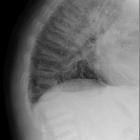osteitis pubis














Osteitis pubis (OP) is characterized by non-infectious inflammation of the pubic symphysis.
Clinical presentation
The presentation is typical with varying degrees of pelvic and/or perineal pain, reproduced on hip adduction.
Pathology
Although the etiology is sometimes unknown, the most common causes are:
- pregnancy/childbirth
- high-level of athletic activity: see athletic pubalgia
- urological or gynecological surgery
- trauma
- psoriatic arthritis
- ankylosing spondylitis
Radiographic features
Plain radiograph and CT
The x-ray and CT findings are subchondral erosive change, joint irregularity and sclerosis, which may eventually lead to ankylosis. Positive findings usually are not apparent until 4 weeks after the onset of symptoms
MRI
MRI may demonstrate parasymphyseal bone marrow edema although this finding may also be seen in asymptomatic individuals. Symphyseal fluid and peripubic soft-tissue edema during initial stages may also be seen .
Subchondral sclerosis, subchondral resorption and bony margin irregularities, and osteophytes may be seen with the chronicity of disease .
Nuclear medicine
Bone scans may be negative but can demonstrate intense signal uptake at the pubic symphysis.
Treatment and prognosis
Treatment is symptomatic and mainly relies upon rest. Symphyseal cleft injections can be performed for diagnostic and therapeutic measures, gaining short-term symptom relief in small case series .
Differential diagnosis
The main differential diagnoses are infection and hyperparathyroidism, the latter due to bone resorption. On MRI, the initial stages of osteitis pubis may mimic osteomyelitis .
Siehe auch:
- Femoro-acetabuläres Impingement
- primärer Hyperparathyreoidismus
- Insuffizienzfraktur
- Piriformis-Syndrom
- Osteomyelitis Os pubis
- Symphysitis
- Leistenschmerz bei Sportlern
- Bridging of symphysis pubis
und weiter:

 Assoziationen und Differentialdiagnosen zu osteitis pubis:
Assoziationen und Differentialdiagnosen zu osteitis pubis:





